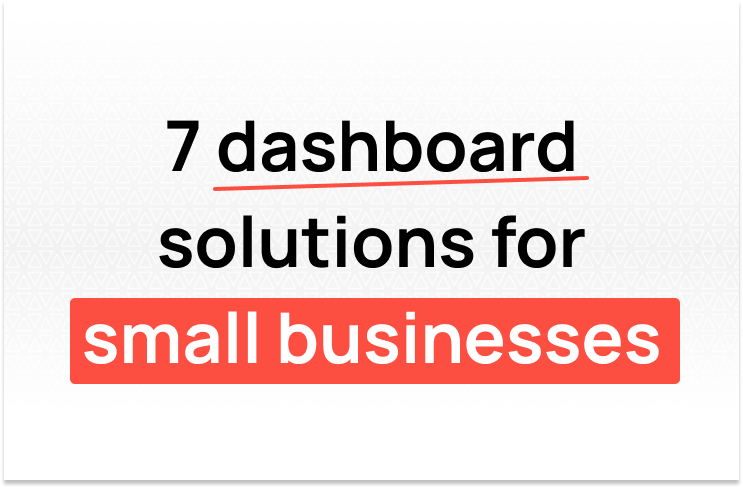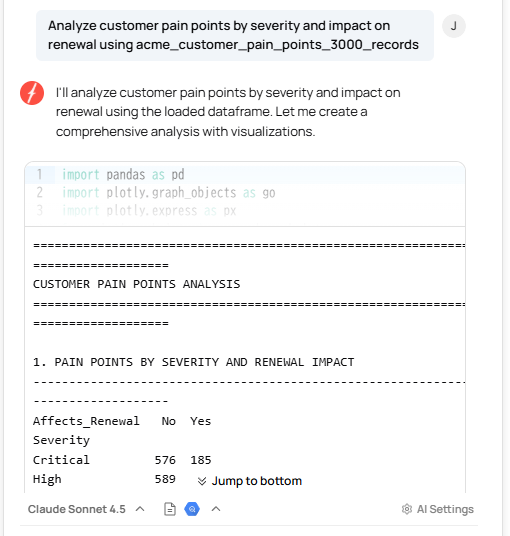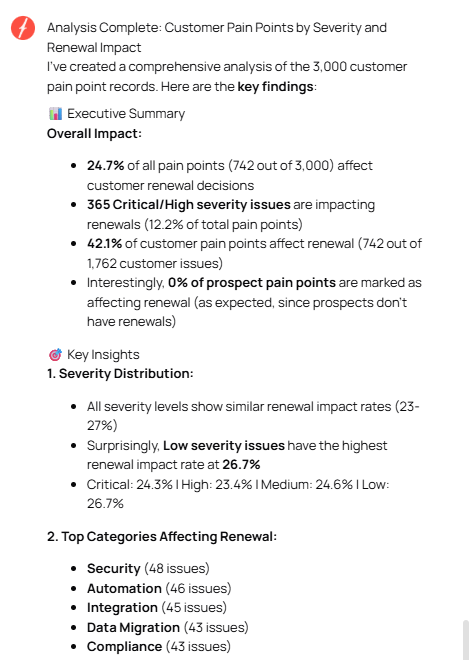
Turn your small business data into decisions with the right dashboard solution that fits your small business needs.
TL;DR: Traditional BI dashboards can't answer certain questions fast enough. AI for BI changes that by enabling non-technical stakeholders to explore data using natural language, delivering insights in minutes instead of weeks. This self-service approach frees data teams from repetitive requests while giving business decision-makers immediate access to the answers they need.
Do you need AI for BI? To answer that question, let’s consider the following scenario.
One day, you have a unique idea about your company’s go-to-market strategy. Some new potential scenarios you want to test to see if there’s any substance to your hunch.
You know your company has the data. But you may not have the time (or the know-how) to pull it all together, combine it, massage it, and build the visuals you need. And the question’s too advanced for any of your existing BI dashboards.
Business stakeholders are increasingly running into these scenarios. They have an idea, but no way to confirm or test it. Going through the traditional channels - asking for a data pipeline and accompanying reports - may take so long that, by the time it’s done, the business opportunity has passed you by.
This is where you may resort to ad hoc analysis - playing around with the data yourself to see what questions it can answer. Even then, however, you may find there’s a limit to what you can do on your own.
Most companies, regardless of size, would benefit from the kind of self-service analytics that makes answering such questions possible. Unfortunately, self-service infrastructure isn’t easy to build. And most self-service systems are user-unfriendly, requiring strong technical chops to use skillfully.
This is where AI for BI can play a pivotal role. AI for BI can give you greater control over your data, generating insights in minutes rather than weeks.
In this article, we’ll dive into exactly how AI for BI enables ad hoc analysis so you can self-service answers to the questions you need resolved now, regardless of your technical expertise. We’ll also see how AI for BI can help you collaborate better with your in-house data engineers when questions get complicated. Finally, we’ll touch on the AI BI tools you can use to make AI-powered BI a reality.
Traditional BI tools have their place - a sizable one - in the data landscape. They deliver trusted, reliable, and well-governed data in an accessible format without you needing to understand how it all works under the hood.
But BI dashboards don’t cover everything. There are a few places they fall flat:
You likely have many BI dashboards. Possibly too many. It can be hard, even with a straightforward question, to find the answers you need.
That’s especially true if your question is novel or original. In all likelihood, no one’s thought of structuring the data or presenting it in the way required to answer your question. It may also be that, as one of the business stakeholders closest to the data, you understand it - and the potential that lies within - in ways your data engineers don’t.
This is where ad hoc analysis comes in. Ad hoc analysis helps answer one-off business questions outside of the normal rhythm of the data lifecycle so that you can make more timely, data driven decisions.
The problem is that, at the outset, you may not know exactly what data you need or how to express what you’re looking for. You may require an extended period of ad hoc data analysis, slicing and dicing your data in multiple ways in search of answers. Sometimes, you don’t even know what your hypothesis is until you see a pattern in the data.
This requires gathering all your data from disparate sources and slicing and dicing it into the shape you need. This can quickly become a stressful and error-prone process. You may also feel like your data slicing chops aren’t strong enough to present the data in the way you need.
You may be a SQL or Excel wizard. In the end, however, you may find that some problems really do require the data team’s assistance to take them to the next level.
The problem is that, traditionally, this requires a lot of delayed back-and-forth between stakeholders and the data team. You give the team your requirements. They build what they think you need. You provide feedback. The cycle repeats - for days or weeks - until both sides converge on a solution.
Unfortunately, there aren’t many ways (without AI) to speed up this process. Engineers are doing the best they can with limited resources and increasing demands for data. And there aren’t many tools that enable more streamlined and collaborative approaches. Most are focused on creating dashboards, full stop.
All of these factors have limited the ability of non-technical business people to profile and ask questions of their data.
That changes with the advent of AI for BI.
AI for BI combines the natural language processing and analytical capabilities of GenAI to automatically combine, clean, and analyze data. It abstracts away the details of merging and querying data, creating tables and generating queries (e.g., using SQL) automatically from natural language prompts.
With AI for BI, non-technical users can explore data in several ways.
Exploratory data analysis (EDA) profiles your data, answering critical questions about its nature and structure. This step is crucial for performing any kind of analysis on data, and until now, has been hindered by the data team's expertise and bandwidth. AI for BI can provide non-technical users with details such as the type of information represented, patterns and outliers, mean and standard deviation, inconsistency in formatting, etc. EDA can reveal patterns and trends that stakeholders are not aware of, which are critical for guiding the business in the right direction.
Ad hoc analysis builds on EDA by asking one-off questions of your data. It’s used either to test a new hypothesis or provide a quick answer to a time-sensitive business issue. It gives users the ability to react to unexpected market changes, business events, or stakeholder requests that can’t be answered by standard business reporting.
Ad hoc analysis is indispensable for dealing with change and discovering new opportunities. AI for BI enables this for every decision-maker who’s close to the business and its data, regardless of their technical prowess.
Standard reporting is still good and necessary. Without ad hoc analysis, however, your business is leaving a lot of potential value on the table. Ad hoc analysis drives exploratory questions that open up new opportunities and change how your business fundamentally works.
Even the world’s best dashboards can’t deliver the answers to questions that no one’s ever asked. With AI for BI, business stakeholders have a powerful tool for answering out-of-band questions at a moment’s notice.
Embedded AI and BI. AI isn’t only useful as a standalone tool. By embedding natural language query capabilities in existing dashboards, users can dig more deeply into the data, either narrowing it down or combining data across multiple dashboards to yield new insights.
Embedded AI is a win-win for both stakeholders and data engineering teams. Stakeholders get a new mechanism for easy, instant access to data. Data engineering teams can enable more self-service options in a gated, governed fashion that reduces the risk of compliance issues.
AI for BI can help small business teams do more with less by empowering business stakeholders to follow their hunches and see where they lead. This can unlock massive opportunities.
As a real-world example, Fabi worked with Parasail to enable AI for BI solutions for their AI deployment network. Their product team wanted enterprise-level analytics. However, as a startup, it didn’t have enterprise-level resources. Without a dedicated BI expert on the team, they struggled with how to turn the data they’d collected into actionable insights.
Using Fabi, Parasail was able to connect to its authoritative data sources (PostgreSQL, Stripe, Hubspot, etc.), cleanse their data automatically using AI, and generate the required SQL queries and Python code for data analysis using English-language prompts.
The results were striking:
The people closest to the business are usually the people who know their business’s data the best. However, they can’t always leverage their expertise because they’re not technical wizards (nor should they be expected to become ones).
Let’s be honest: Many data engineers are skeptical of AI. When they hear “AI,” some of them think “slop.”
That’s not unwarranted. Most LLMs are good general-purpose language parsing engines, but lack the contextual data and guardrails required to output accurate answers in a specific problem domain. The result is that they end up yielding “answers” riddled with inaccuracies.
With high-quality input, however, AI for BI tools deliver a high degree of accuracy at a fraction of the time required to generate insights with traditional BI solutions. AI for BI is a useful, accurate tool that can provide numerous benefits to the data team:
Data teams are beset with requests about data. So much so that they often detract from the time engineers have to work on more important tasks, such as data infrastructure. It also frustrates most data engineers, whose skills extend far beyond generating mundane SQL queries.
Every question a stakeholder answers with AI for BI is a question that doesn’t land in the engineering support queue. That means the data team has more time to work on the tasks that demand their advanced skillset.
Engineers can do more with AI - and in less time - than they would be able to do coding everything by hand. Because AI can process far more data than is possible for human beings, it can deliver more complex results. Engineers can use AI to build predictive models and build custom dashboards and workflows in seconds - regardless of whether they’re Python data wrangling experts.
Business stakeholders aren’t the only ones who can use AI for BI for ad hoc analysis. Engineers can also use it to test out initial hypotheses without investing a ton of time in writing clean code.
Even better, data engineers can build upon the code that AI for BI generates to further refine the answer into what the business needs. This is a powerful combination that combines the time savings and ease of use of AI with the rich technical and business knowledge of the engineer.
By enabling data engineers and stakeholders to prototype together, AI for BI cuts down on the back-and-forth involved when requirements get lost in translation. This reduces the amount of rework engineers are required to perform, cutting down on wasted effort.
Thanks to AI that powers text-to-SQL and text-to-Python, data teams and data engineers can quickly create custom, interactive Python dashboards in ways that simply are not possible in legacy BI given the constraints of those existing tools to their charting capabilities. With text-to-Python, the options for generating custom interactive dashboards are nearly endless thanks to libraries such as matplotlib, plotly and altair.
A lot of companies have struggled with how to offer some form of self-service analytics. Typically, this requires building out infrastructure that’s expensive to both create and maintain.
AI for BI greatly simplifies getting started with self-serve analytics and ad hoc analysis. You only need two things:
Access to AI-ready data. This can be in the form of a connection to a data warehouse or the spreadsheets you use to manage key parts of your day-to-day business. It doesn’t have to be perfect. What’s important is that you have a small, granular, and relatively clean set of tables.
An AI BI tool. Ad hoc analysis works best with the right tools. While you can feed data questions directly to an LLM, you won’t get the quality or performance you need. You also can’t easily share your work, ensure it’s reproducible, or convert it into an interactive dashboard.
AI BI tools provide a secure, enterprise-grade environment for experimenting with data, with features such as ease of use, trial and error exploration, and real-time collaboration. They also alleviate the need for the data team to create its own self-service analytics solution, saving both time and capital.
Fabi is an AI-native data analysis tool that enables you to explore your data 10x faster than non-AI platforms. Using Fabi, you can deliver insights in minutes in an all-in-one tool that delivers reporting without needing to switch between tools.
Fabi supports:
No-code solution for business decision-makers. You can use Fabi strictly through a natural language interface, asking and refining questions in an iterative manner.
Connecting to various data sources. Fabi can connect to all popular data warehouses and also ingest data in Google Sheets, CSV, JSON, Excel, and Parquet formats.
Seamless round-tripping. A lot of tools can convert text to SQL. Fabi goes one step further by supporting tools and workflows to make it easier to collaborate more closely with your data team. You can work in natural language and/or SQL, and then you and/or your data team can edit the generated SQL/Python code for your generated solution.
Easy reporting. Bundle up your insights into a dashboard and share them with others across the company.
Real-time collaborative workspace. Fabi brings you and your data team together in a collaborative workspace, where you can iterate on solutions and verify generated code together.
Getting started with Fabi is easy and only requires familiarizing yourself with a few core concepts:

To see Fabi in action, create a free account. From there, you can upload and analyze any data.
Let’s say, for example, that you have GTM-related data you want to analyze to identify missed regional sales opportunities. You can start by uploading the data as individual files. Fabi will automatically parse and load each CSV file into a table.

From there, you can ask Fabi anything you want about your data. For example, you can simply ask it to describe the data and tell you what it contains.


Fabi will also generate hints about other questions you can ask your data. Using one of the examples above, you can analyze product pain points and potential impact on service renewal across all your customers.
You’ll notice that, besides generating a final result, Fabi generates and displays several intermediate data products, including charts and graphs. You can examine these to verify that Fabi is analyzing the data correctly. (You’ll notice that Fabi also provides the SQL and Python code for the queries and visualizations they generate, enabling you to dig even deeper if you wish.)

From there, Fabi will generate a final summary with key findings. In this case, it identifies that 24.7% of customer pain points - issues such as automation, data migration, etc. - affect product renewal. Counterintuitively, it finds in this case that low-severity issues are leading to the highest percentage of non-renewal, signaling that cumulative frustration (as opposed to any single large, blocking issue) may play a role in renewal decisions.

You can continue conversing with the AI in this fashion. AI BI tools like Fabi work best when you treat them as a “data assistant.” Instead of asking for direct answers, ask the same questions you might ask yourself about your data.
The goal of AI for BI isn’t to “cut out” or short-circuit your data team. Rather, the goal is to supercharge them.
AI for BI gives you a powerful tool for self-service analytics. That frees your data engineering team from answering random ad hoc questions, allowing them to focus more on advanced machine learning, custom reporting, and essential data infrastructure. It turns business teams into data-literate partners who can answer their own questions.
AI for BI isn’t a silver bullet. For example, if you don’t have enough data, AI BI tools may make mistaken and misleading assumptions. You also can’t process significantly large datasets, due to the inherent limitations of LLMs.
These limitations don’t detract from AI for BI’s general utility as an ad hoc analysis platform. With the right tool, you can immediately gain a new perspective on your data and fresh insights into how to run your business.